Temporal and Spatial Analysis of Deformation Monitoring of the Ming Great Wall in Shanxi Province through InSAR
Abstract
:1. Introduction
2. Study Area and Data Sources
2.1. Overview of the Study Area
2.2. Overview of the Dataset
3. Research Methodology
3.1. Principle of Small Baseline Subset Time Series Analysis Technique
3.2. Data Processing Procedure
4. Analysis of Results
4.1. Analysis of Subsidence Monitoring along the Great Wall Area
4.2. Analysis of Subsidence Monitoring in the Area along the Great Wall
4.3. Risk Mapping Analysis along the Great Wall Corridor
5. Conclusions
Author Contributions
Funding
Institutional Review Board Statement
Informed Consent Statement
Data Availability Statement
Conflicts of Interest
References
- Lombardo, L.; Tanyas, H.; Nicu, I.C. Spatial modeling of multi-hazard threat to cultural heritage sites. Eng. Geol. 2020, 277, 105776. [Google Scholar] [CrossRef]
- Xu, H.; Chen, F.; Zhou, W. A comparative case study of MTInSAR approaches for deformation monitoring of the cultural landscape of the Shanhaiguan section of the Great Wall. Herit. Sci. 2021, 9, 71. [Google Scholar] [CrossRef]
- Bosiljkov, V.; Uranjek, M.; Arni, R.; Bokan-Bosiljkov, V. An integrated diagnostic approach for the assessment of historic masonry structures. J. Cult. Herit. 2010, 11, 239–249. [Google Scholar] [CrossRef]
- Pasek, J.; Gaya, H.P. Numerical simulations of the influence of temperature changes on structural integrity of stone temples in Angkor, Cambodia. Appl. Math. Comput. 2015, 267, 409–418. [Google Scholar] [CrossRef]
- Chen, F.; Xu, H.; Zhou, W.; Deng, W.; Parcharidis, I. Three-dimensional deformation monitoring and simulations for the preventive conservation of architectural heritage: A case study of the Angkor Wat Temple, Cambodia. GISci. Remote Sens. 2021, 58, 217–234. [Google Scholar] [CrossRef]
- Nuttens, T.; Wulf, A.D.; Deruyter, G.; Stal, C. Deformation monitoring with terrestrial laser scanning: Measurement and processing optimization through experience. In Proceedings of the Presented at the 12th International Multidisciplinary Scientific GeoConference SGEM 2012, Sofia, Bulgaria, 17–23 June 2012; pp. 707–714. [Google Scholar]
- Tapete, D.; Cigna, F. Site-specific analysis of deformation patterns on archaeological heritage by satellite radar interferometry. MRS Online Proc. Libr. (OPL) 2012, 1374, 283–295. [Google Scholar] [CrossRef]
- Suziedelyte-Visockiene, J.; Bagdziunaite, R.; Malys, N.; Maliene, V. Close-range photogrammetry enables documentation of environment-induced deformation of architectural heritage. Environ. Eng. Manag. J. 2015, 14, 1371–1381. [Google Scholar]
- Sesana, E.; Gagnon, A.S.; Ciantelli, C.; Cassar, J.; Hughes, J.J. Climate change impacts on cultural heritage: A literature review. Wiley Interdiscip. Rev. Clim. Chang. 2021, 12, e710. [Google Scholar] [CrossRef]
- Garziera, R.; Amabili, M.; Collini, L. Structural health monitoring techniques for historical buildings. In Proceedings of the IV Pan American Conference for Non Destructive Testing, Buenos Aires, Argentina, 22–26 October 2007; pp. 1–12. [Google Scholar]
- Sigurdardottir, D.H.; Glisic, B. On-site validation of fiber-optic methods for structural health monitoring: Streicker Bridge. J. Civil Struct. Health Monit. 2015, 5, 529–549. [Google Scholar] [CrossRef]
- De Smet, T.S.; Everett, M.E.; Warden, R.R.; Komas, T.; Hagin, J.N.; Gavette, P.; Martini, J.A.; Barker, L. The fate of the historic fortifications at Alcatraz island based on terrestrial laser scans and ground-penetrating radar interpretations from the recreation yard. Near Surf. Geophys. 2019, 17, 151–168. [Google Scholar] [CrossRef]
- Everett, M.E.; DeSmet, T.S.; Warden, R.R.; Ruiz-Guzman, H.A.; Gavette, P.; Hagin, J. The Fortress Beneath: Ground Penetrating Radar Imaging of the Citadel at Alcatraz: 1. A Guide for Interpretation. Heritage 2021, 4, 1328–1347. [Google Scholar] [CrossRef]
- Li, X. Monitoring of the Ming Great Wall Sites in Zhenbeita and its Surrounding Areas. Doctoral Dissertation, Harbin Institute of Technology, Harbin, China, 2016. [Google Scholar]
- Yu, B. Comprehensive Conservation and Management of the Great Wall in China: Challenges and Explorations. China Cult. Herit. 2018, 31–40. [Google Scholar]
- Chen, Y.; Zhang, X.; Liu, J.; Hou, L.; Niu, H.; Gao, S. Research on monitoring and early warning of rammed earth Great Wall on the Silk Road in China—Taking Jiayuguan Pass as an example. J. Shandong Univ. Technol. (Nat. Sci. Ed.) 2018, 32, 56–60. [Google Scholar] [CrossRef]
- Tapete, D.; Cigna, F. Trends and perspectives of space-borne SAR remote sensing for archaeological landscape and cultural heritage applications. J. Archaeol. Sci. Rep. 2017, 14, 716–726. [Google Scholar] [CrossRef]
- Copernicus for Cultural Heritage: Satellites to Preserve the Legacy from Our Past. Copernicus. Available online: https://www.copernicus.eu/en/copernicus-cultural-heritage-satellites-preserve-legacy-our-past (accessed on 26 April 2019).
- EURISY Space4Culture: Satellite Services for Historical and Creative Cities. Proceedings and Main Messages of the Conference. Available online: https://drive.google.com/file/d/1NKao-0HK2NPmVpwVRq2vbdHjrJ2AL6wY/view (accessed on 26 April 2019).
- Adams, R.E.; Brown, W.E.; Culbert, T.P. Radar mapping, archeology, and ancient Maya land use. Science 1981, 213, 1457–1468. [Google Scholar] [CrossRef] [PubMed]
- Tapete, D.; Cigna, F. COSMO-SkyMed SAR for Detection and Monitoring of Archaeological and Cultural Heritage Sites. Remote Sens. 2019, 11, 1326. [Google Scholar] [CrossRef]
- Elachi, C.; Roth, L.E.; Schaber, G.G. Spaceborne Radar Subsurface Imaging in Hyperarid Regions. IEEE Trans. Geosci. Remote Sens. 1984, 22, 383–388. [Google Scholar] [CrossRef]
- Moore, E.; Freeman, T.; Hensley, S. Spaceborne and Airborne Radar at Angkor: Introducing New Technology to the Ancient Site. In Remote Sensing in Archaeology; Springer: New York, NY, USA, 2006; pp. 185–216. [Google Scholar]
- Wiseman, J.; El-Baz, F. (Eds.) Interdisciplinary Contributions to Archaeology. In Remote Sensing in Archaeology; Springer: New York, NY, USA, 2007; p. 334. [Google Scholar]
- Zhu, J.; Li, Z.; Hu, J. InSAR Deformation Monitoring Methods and Research Progress. Acta Geod. Cartogr. Sin. 2017, 46, 1717–1733. [Google Scholar]
- Liu, G. Basic Principles of InSAR. Sichuan Surv. Mapp. 2004, 187–190. [Google Scholar]
- Colesanti, C.; Ferretti, A.; Novali, F.; Prati, C.; Rocca, F. SAR monitoring of progressive and seasonal ground deformation using the permanent scatterers technique. IEEE Trans. Geosci. Remote Sens. 2003, 41, 1685–1701. [Google Scholar] [CrossRef]
- Kampes, B.M.; Hanssen, R.F. Ambiguity resolution for permanent scatterer interferometry. IEEE Trans. Geosci. Remote Sens. 2004, 42, 2446–2453. [Google Scholar] [CrossRef]
- Ferretti, A.; Prati, C.; Rocca, F. Permanent scatterers in SAR interferometry. IEEE Trans. Geosci. Remote Sens. 2001, 39, 8–20. [Google Scholar] [CrossRef]
- Ferretti, A.; Prati, C.; Rocca, F. Nonlinear subsidence rate estimation using permanent scatterers in differential SAR interferometry. IEEE Trans. Geosci. Remote Sens. 2000, 38, 2202–2212. [Google Scholar] [CrossRef]
- Berardino, P.; Fornaro, G.; Lanari, R.; Sansosti, E. A new algorithm for surface deformation monitoring based on small baseline differential SAR interferograms. IEEE Trans. Geosci. Remote Sens. 2002, 40, 2375–2383. [Google Scholar] [CrossRef]
- Zhou, L.; Li, J.; Wang, C.; Li, S.; Zhu, Z.; Lu, J. Monitoring and Analysis of Subway Settlement along the Metro Lines in Shanghai from 2018 to 2020 Based on Time-Series InSAR. J. Geod. Geodyn. 2021, 41, 1177–1182. [Google Scholar]
- Liu, K.; Gong, H.; Chen, B. Ground Subsidence Monitoring and Analysis of Beijing Metro Line 6 Based on InSAR Data. J. Geo-Inf. Sci. 2018, 20, 128–137. [Google Scholar]
- Liu, Q.; Yue, G.; Ding, X.; Yang, K.; Feng, G.; Xiong, Z. Spatiotemporal Deformation Analysis of Foshan Metro Line Based on Time-Series InSAR. J. Wuhan Univ. (Inf. Sci. Ed.) 2019, 44, 1099–1106. [Google Scholar]
- Guo, Z. Monitoring Bridge Deformation and Surrounding Ground Subsidence Using Time-Series InSAR Technology. Doctoral Dissertation, China University of Mining and Technology, Xuzhou, China, 2021. [Google Scholar]
- Zhang, D.; Tang, X.; Li, Y. Deformation Information Extraction and Analysis of Steel Truss Girder Bridge Based on SBAS-InSAR Technology. J. Shandong Univ. Sci. Technol. (Nat. Sci. Ed.) 2023, 42, 10–17. [Google Scholar]
- Gao, E. Study on Deformation Monitoring along High-Speed Railway Based on High-Resolution SAR Images. Doctoral Dissertation, Southwest Jiaotong University, Chengdu, China, 2017. [Google Scholar]
- Zhu, W.; Wang, B.; Song, H.; Guo, L.; Yang, H. Investigation and monitoring of ground subsidence in Zhengzhou section of Beijing-Guangzhou high-speed railway based on InSAR. Geomat. Spat. Inf. 2019, 42, 61–63. [Google Scholar]
- He, H.; Chen, C.; Chen, F.; Tang, P. Demonstration study on Sentinel-1 SBAS deformation monitoring of the Ming Great Wall scenic corridor in Zhangjiakou. Remote Sens. Land Resour. 2021, 33, 205–213. [Google Scholar]
- Zhu, M.; Chen, F.; Fu, B.; Chen, W.; Qiao, Y.; Shi, P.; Zhou, W.; Lin, H.; Gao, S. Earthquake-induced risk assessment of cultural heritage based on InSAR and seismic intensity: A case study of Zhalang temple affected by the 2021 Mw 7.4 Maduo (China) earthquake. Int. J. Disaster Risk Reduct. 2023, 84, 103482. [Google Scholar] [CrossRef]
- Chen, F.; Zhou, W.; Tang, Y.; Li, R.; Lin, H.; Balz, T.; Luo, J.; Shi, P.; Zhu, M.; Fang, C. Remote sensing-based deformation monitoring of pagodas at the Bagan cultural heritage site, Myanmar. Int. J. Digit. Earth 2022, 15, 770–788. [Google Scholar] [CrossRef]
- Xu, H.; Chen, F.; Zhou, W.; Wang, C. Reducing the Residual Topography Phase for the Robust Landscape Deformation Monitoring of Architectural Heritage Sites in Mountain Areas: The Pseudo-Combination SBAS Method. Remote Sens. 2022, 14, 1178. [Google Scholar] [CrossRef]
- Liu, W. Research on the monitoring system of the Great Wall from the perspective of heritage characteristics analysis. Chin. Cult. Herit. 2018, 85–91. [Google Scholar]
- Li, Z.; Cao, W.; Liu, B.; Luo, Z. Current status and dynamic changes of soil erosion in China. Soil Water Conserv. China 2008, 321, 7–10+72. [Google Scholar]
- Li, M. Study on the characteristics and spatial-temporal distribution of geological hazards in Shanxi Province. Energy Environ. Prot. 2018, 40, 89–93. [Google Scholar]

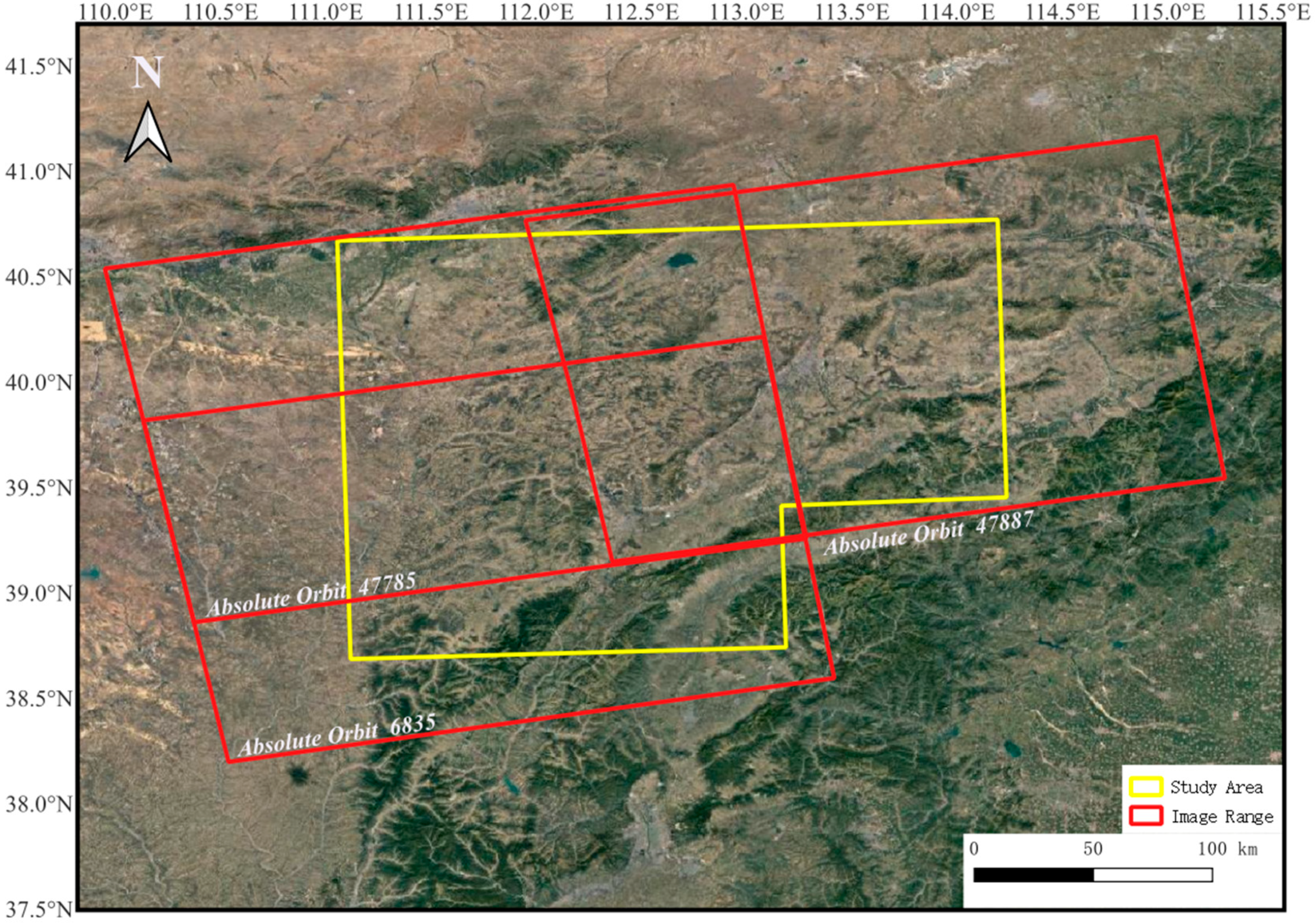
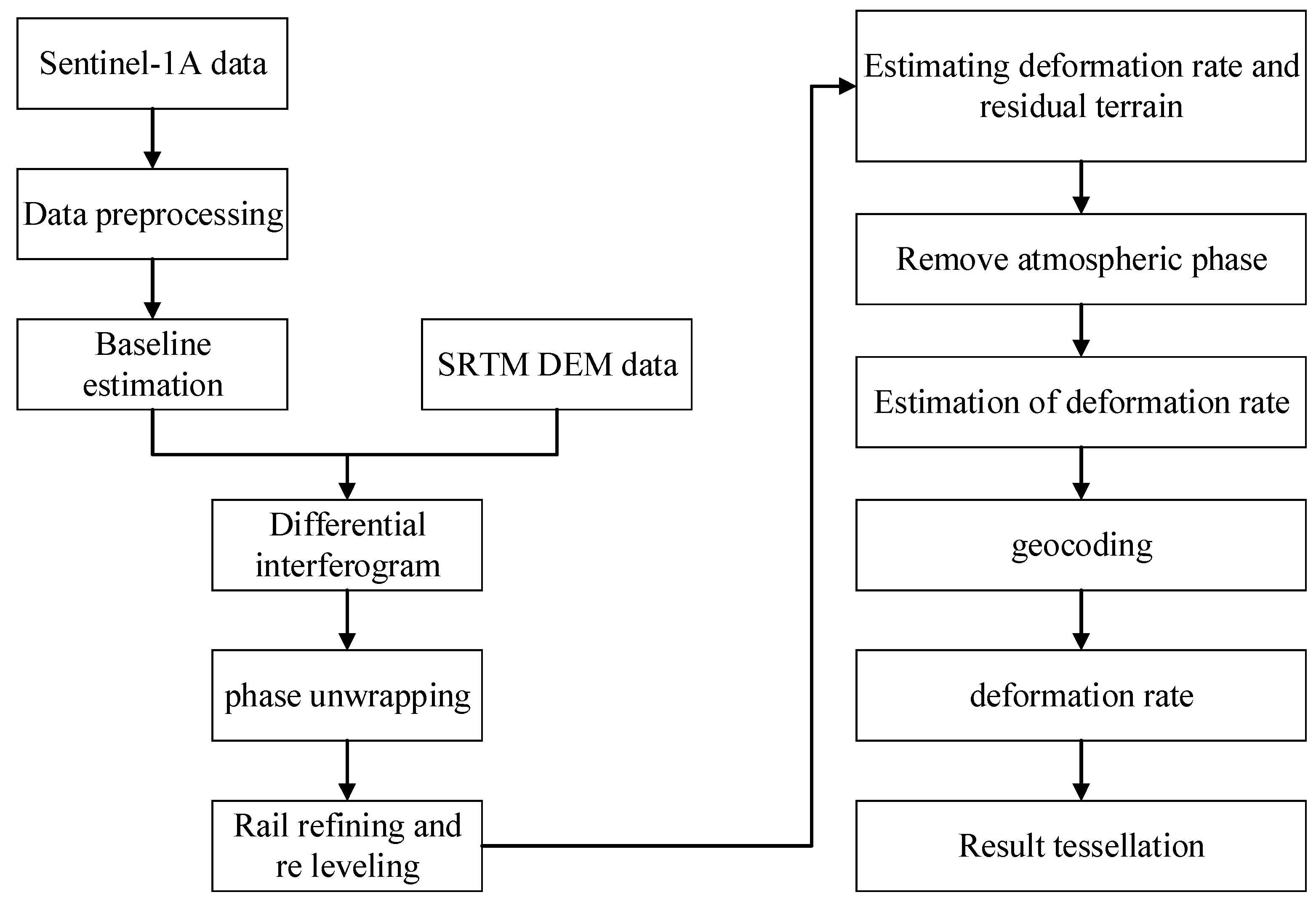


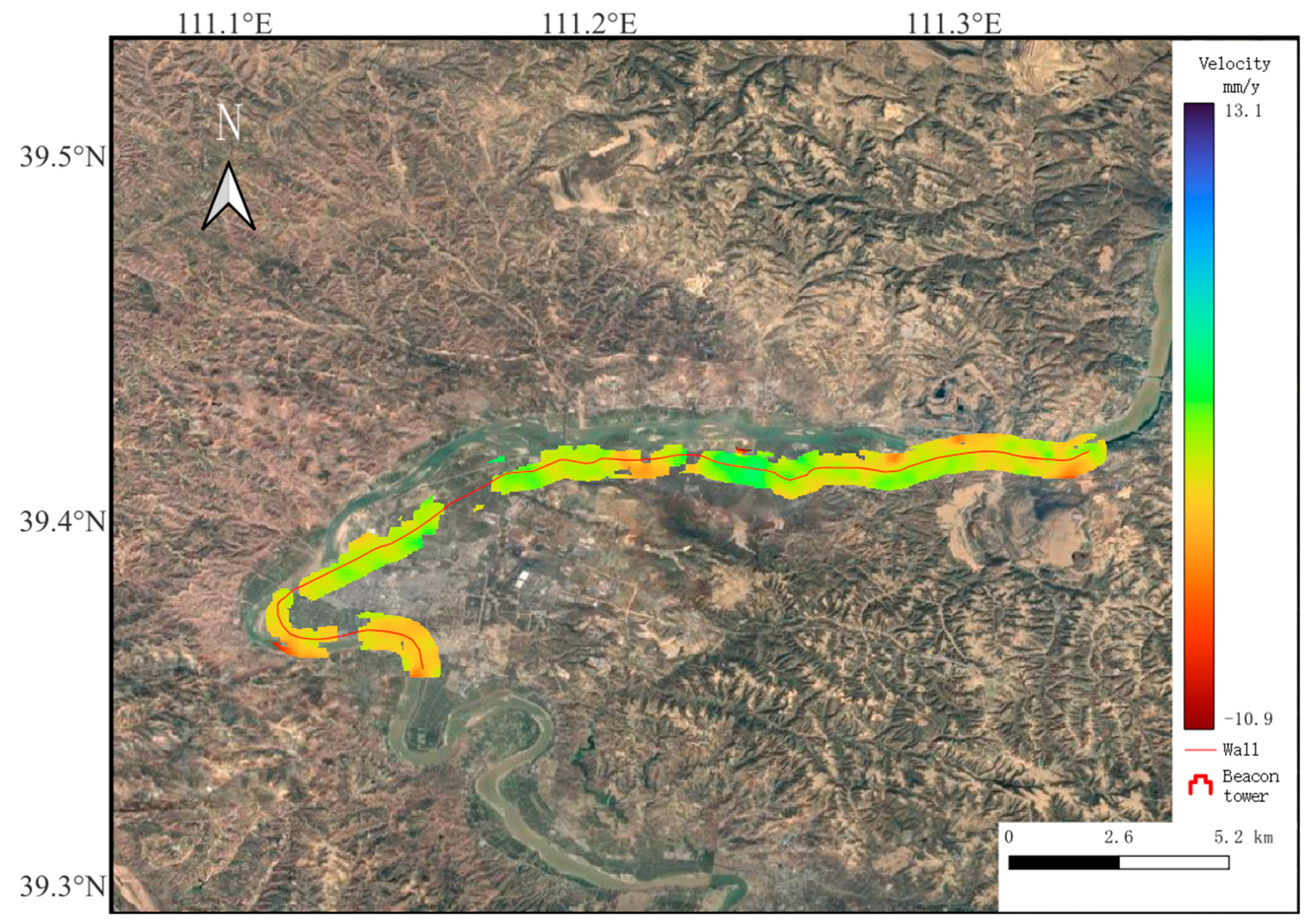
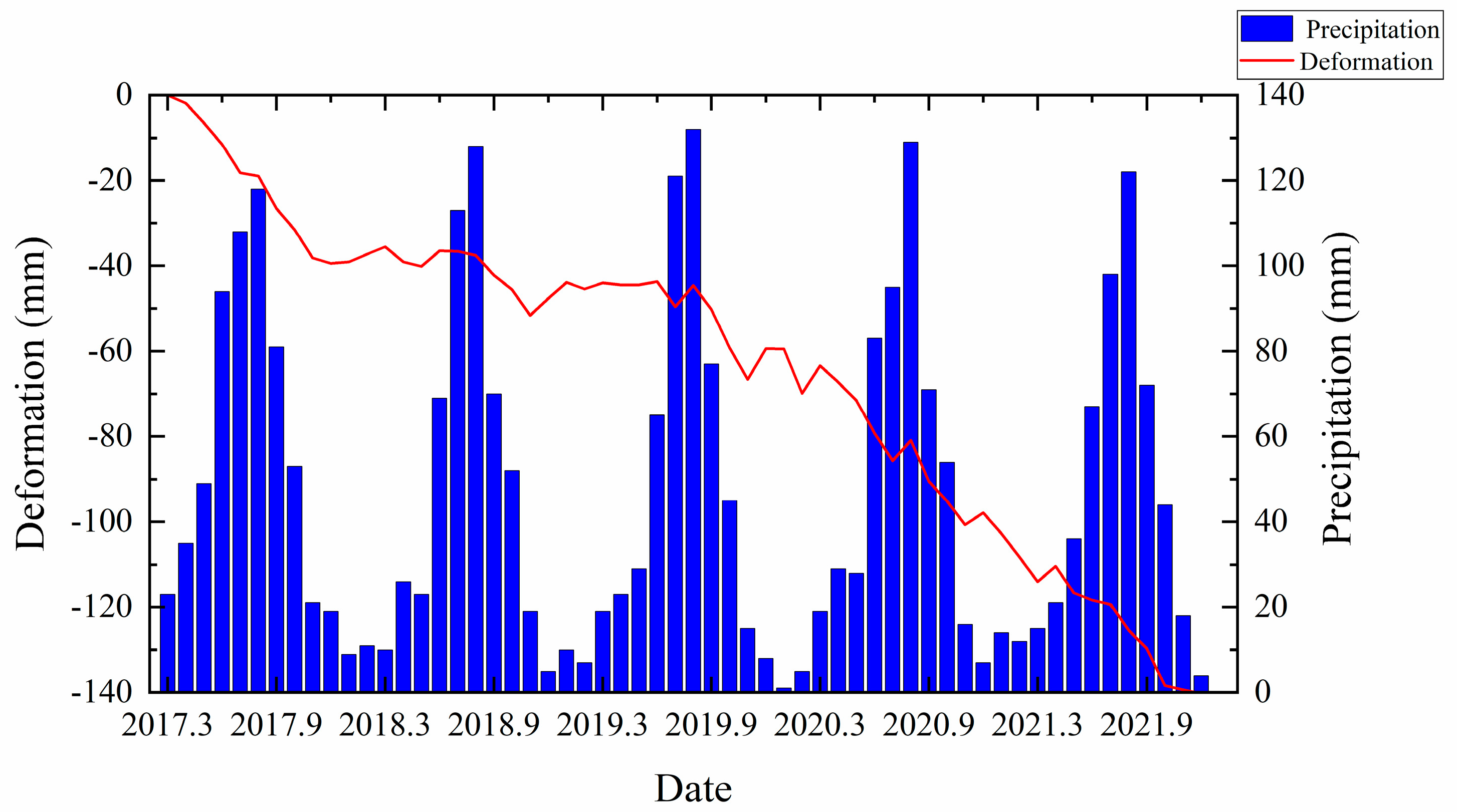
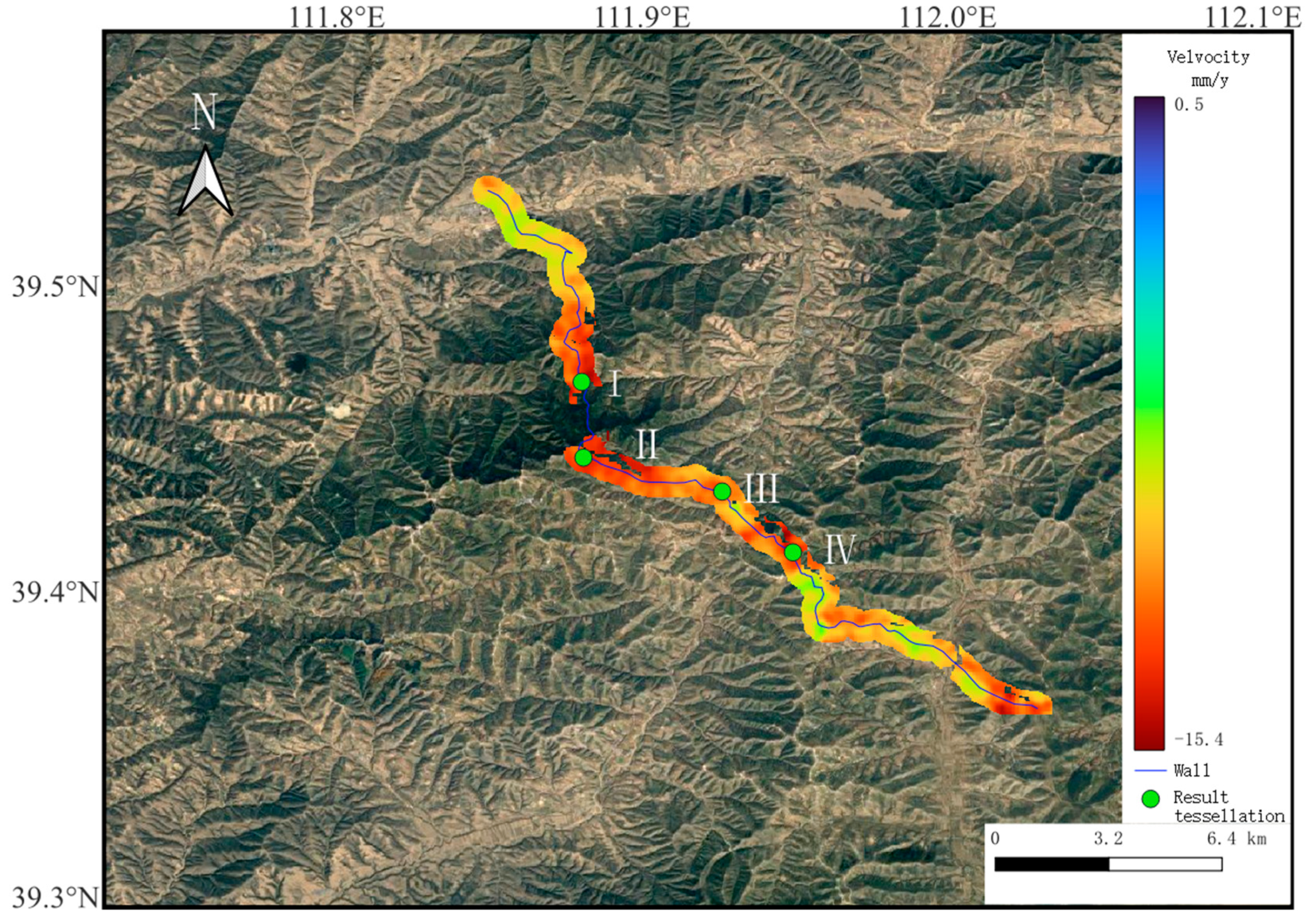
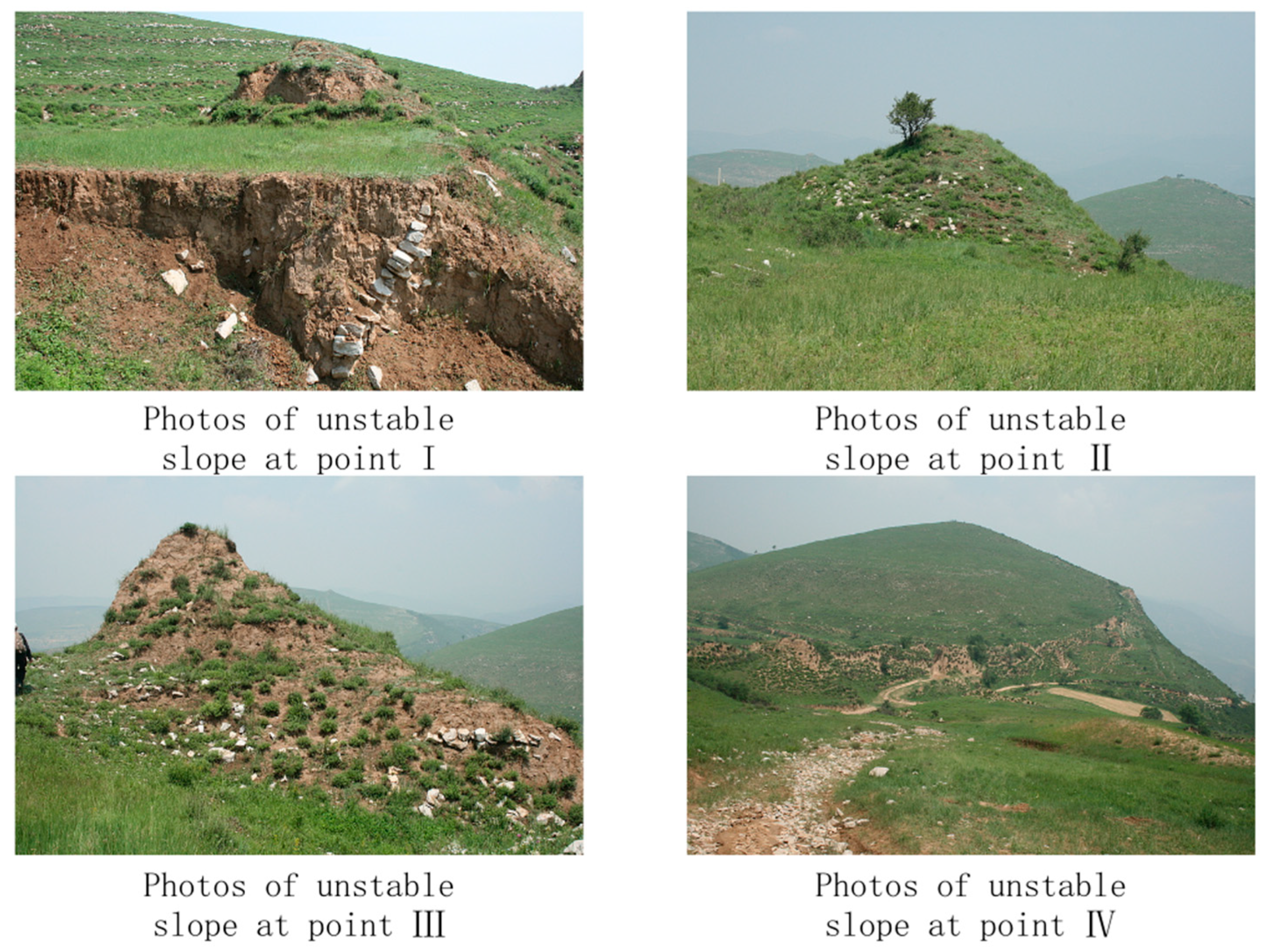

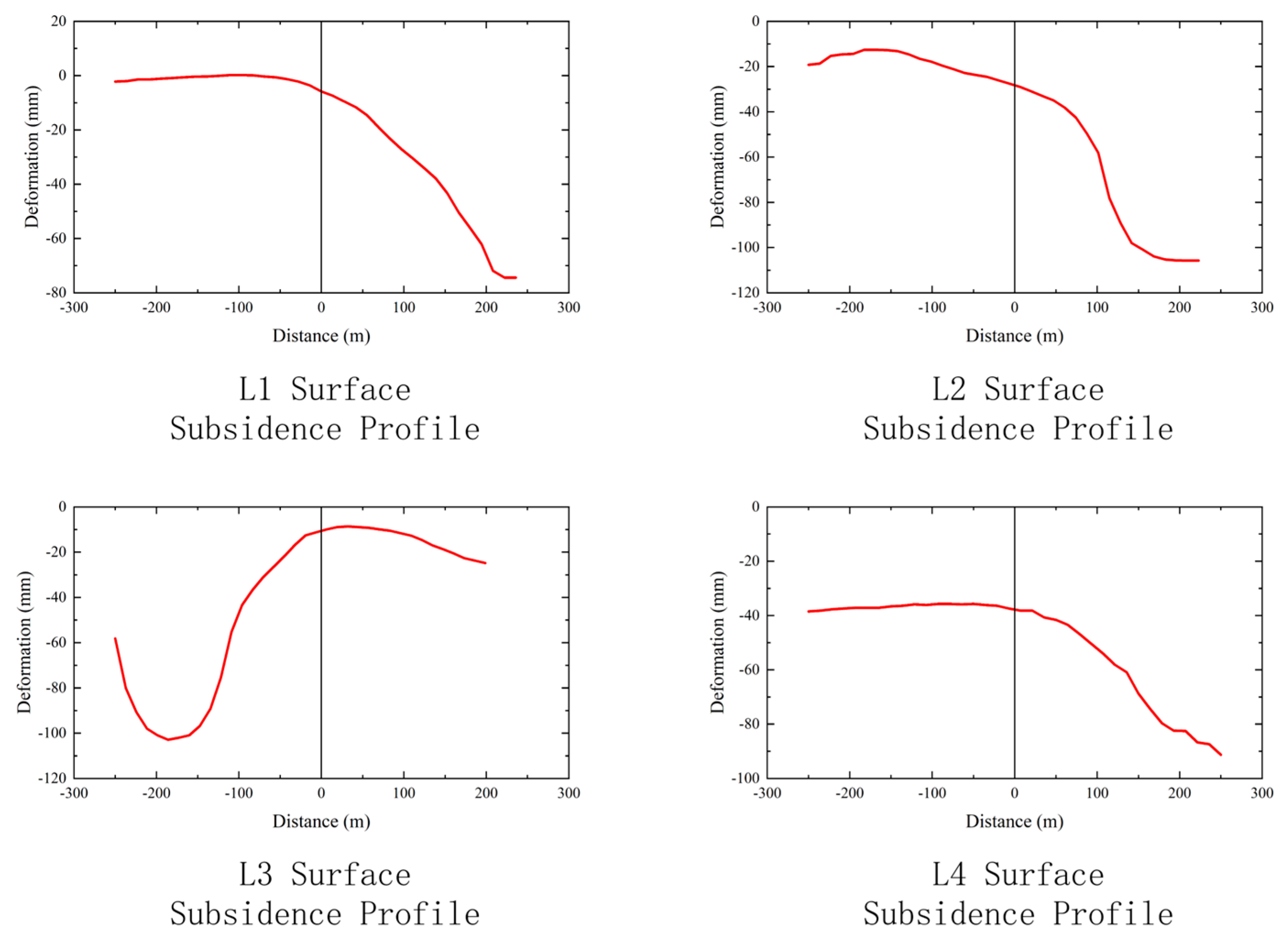
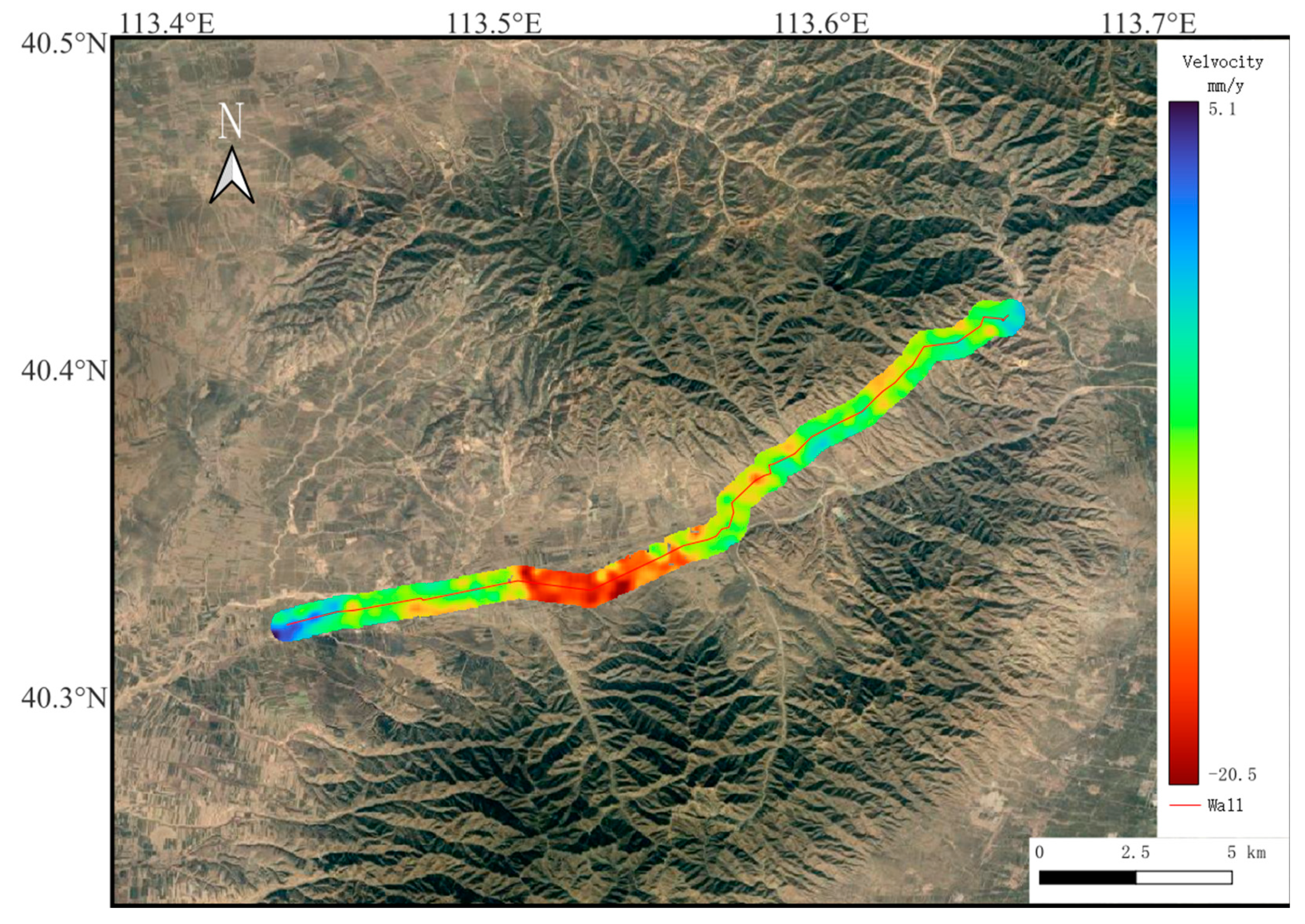
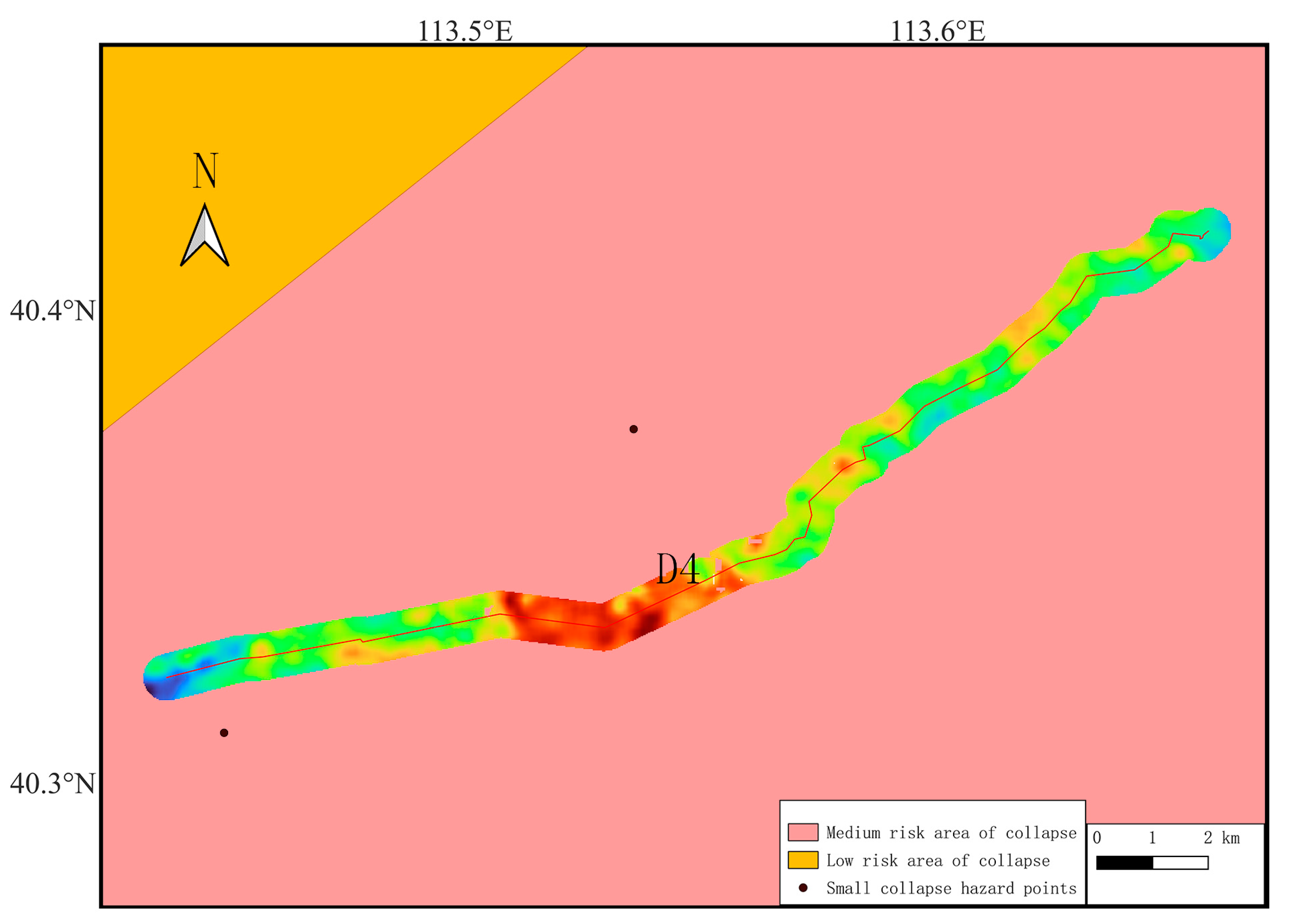
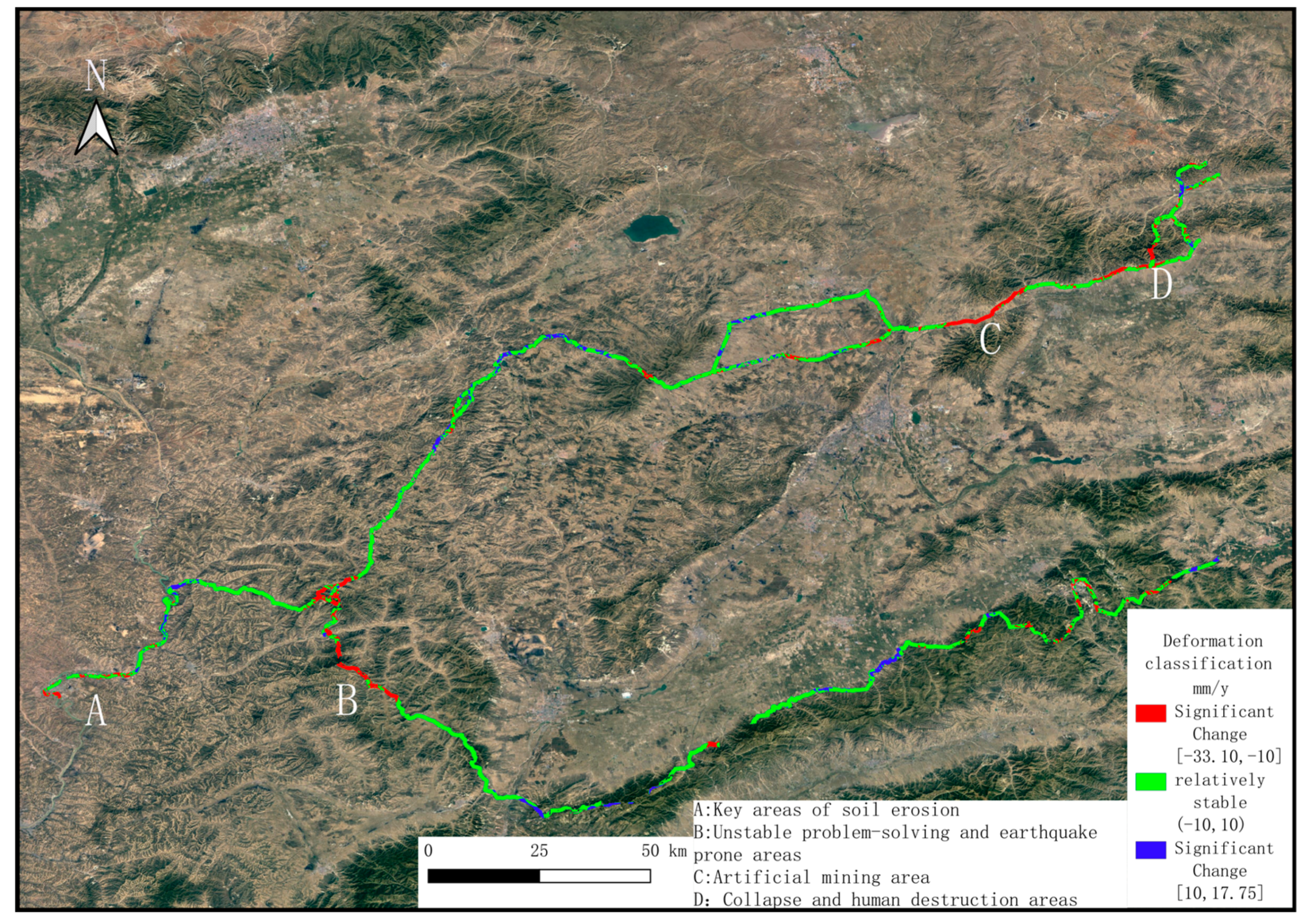
| Satellite | Orbit | Start Date | End Date | Polarization | Number |
|---|---|---|---|---|---|
| S1-A | 47785 | 19 March 2017 | 21 January 2022 | VV | 53 |
| S1-A | 47887 | 14 March 2017 | 4 January 2022 | VV | 57 |
| S1-A | 6835 | 13 March 2017 | 10 January 2022 | VV | 51 |
Disclaimer/Publisher’s Note: The statements, opinions and data contained in all publications are solely those of the individual author(s) and contributor(s) and not of MDPI and/or the editor(s). MDPI and/or the editor(s) disclaim responsibility for any injury to people or property resulting from any ideas, methods, instructions or products referred to in the content. |
© 2023 by the authors. Licensee MDPI, Basel, Switzerland. This article is an open access article distributed under the terms and conditions of the Creative Commons Attribution (CC BY) license (https://creativecommons.org/licenses/by/4.0/).
Share and Cite
Liu, Q.; Wang, X.; Cong, K.; Zhang, J.; Yang, Z. Temporal and Spatial Analysis of Deformation Monitoring of the Ming Great Wall in Shanxi Province through InSAR. Appl. Sci. 2023, 13, 12179. https://doi.org/10.3390/app132212179
Liu Q, Wang X, Cong K, Zhang J, Yang Z. Temporal and Spatial Analysis of Deformation Monitoring of the Ming Great Wall in Shanxi Province through InSAR. Applied Sciences. 2023; 13(22):12179. https://doi.org/10.3390/app132212179
Chicago/Turabian StyleLiu, Qi, Xuan Wang, Kanglin Cong, Junhao Zhang, and Zongheng Yang. 2023. "Temporal and Spatial Analysis of Deformation Monitoring of the Ming Great Wall in Shanxi Province through InSAR" Applied Sciences 13, no. 22: 12179. https://doi.org/10.3390/app132212179
APA StyleLiu, Q., Wang, X., Cong, K., Zhang, J., & Yang, Z. (2023). Temporal and Spatial Analysis of Deformation Monitoring of the Ming Great Wall in Shanxi Province through InSAR. Applied Sciences, 13(22), 12179. https://doi.org/10.3390/app132212179





